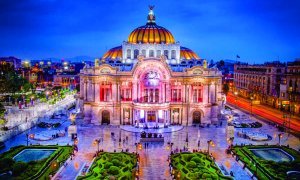 The United Nations Educational, Scientific and Cultural Organisation (UNESCO) is a special branch of the United Nations, based in Paris. The organisation has a list of designated World Heritage sites around the world, which have been selected for preservation due to their unique historical, cultural or physical significance. The aim is to preserve as much beauty in this world as possible and keep it from human and animal destruction.
The United Nations Educational, Scientific and Cultural Organisation (UNESCO) is a special branch of the United Nations, based in Paris. The organisation has a list of designated World Heritage sites around the world, which have been selected for preservation due to their unique historical, cultural or physical significance. The aim is to preserve as much beauty in this world as possible and keep it from human and animal destruction.
The world is full of World Heritage sites. You’ve probably even visited one without realising. But, there are some World Heritage sites that far outdo the others when it comes to how impressive they are. Check out my list of some of the most outstanding man-made World Heritage sites in the world.
Ayutthaya, Thailand
Just North of Bangkok is the ancient city of Ayutthaya, home to some of the most magnificent ruins in Asia. Upon arrival in Ayutthaya, you will be struck at how the city is built around its cultural heritage. Shops, restaurants and hostels sit in between crumbling ruins, palaces and temples. This blending of modernity and Antiquity is as unique as it is fascinating. Rather than being just a tourist attraction, Ayutthaya is a living, breathing relic of Thailand’s glorious and turbulent past.
Chichen Itza, Mexico
There is a lot of mystery surrounding the mystical temple of Chichen Itza. People travel from far and wide to ogle the pyramid at the centre of the ruins complex. Did you know, if you stand near the pyramid and clap, the sound will reverberate off its walls and create a weird pinging sound as it does so? Around the main temple are a number of other temples and ruins, all of which can be respectfully explored by foot under the warm glow of the Mexican sun.
Petra, Jordan
Petra, also known as the Rose City, is without a doubt the gem in Jordan’s glimmering crown. Built into the side of pink sandstone cliffs, the complex is one of a kind and best recognised from its pillared initial façade. Originally, Petra was built as a tomb for a Nabataean king back in the 1st century. Today, it is a sacred place, revered as a feat of engineering genius in a time when such creations were seen as miracles as well as masterpieces.
Nazca Lines, Peru
No-one really knows why the Nazca Lines were drawn, but there are theories. The Nazca Lines form gigantic drawings of animals and plants across the desert of southern Peru. Overall, the drawings take up almost 1000 square kilometres. They date back as early as 200 BC and their significance is still completely unknown. Some historians believe they are representations of constellations, while others think the lines are connected to water. Be sure to take a low plane ride over the top of them to see the lines in all their glory.
Kremlin and Red Square, Russia
Even if you have never been to Moscow, you probably recognise the swirling domes of St. Basil’s Cathedral, which sits at the heart of the Moscow Kremlin. The Kremlin is a fortified area in the middle of Russia’s capital. It has played an important role in Russian history and is considered the very essence of Russia. Nowadays, the Kremlin is just as important as it was during the time of the tsars and is well worth exploring.


































